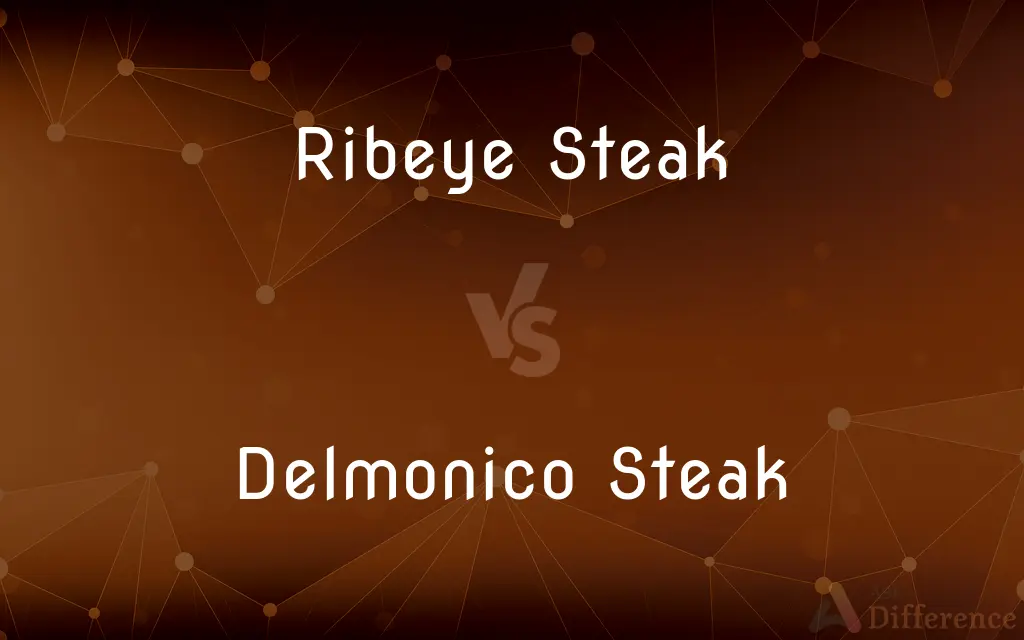Ribeye Steak vs. Delmonico Steak — What's the Difference?
Ribeye steak, known for its rich marbling and flavor, is cut from the rib section. Delmonico steak, a term with varied meanings, often refers to a boneless ribeye, but historically, it can imply different cuts based on the steakhouse or region.

Difference Between Ribeye Steak and Delmonico Steak
Table of Contents
ADVERTISEMENT
Key Differences
Ribeye steaks are celebrated for their generous marbling and tender texture, derived from the beef rib section, typically encompassing ribs six through twelve. This marbling not only contributes to the steak's juiciness but also to its rich, beefy flavor, making it a favorite among steak enthusiasts. Ribeye can be prepared bone-in or boneless, with the bone-in variant sometimes called a "cowboy steak."
Delmonico steak, named after the 19th-century New York City Delmonico's Restaurant, does not refer to a specific cut but rather to a style of preparation or the steak's quality. In many modern contexts, a Delmonico steak is often a high-quality, thick-cut boneless ribeye, chosen for its marbling and flavor. However, the term has historically been applied to various cuts, including the New York strip, depending on the establishment and geographical location.
The primary distinction between a ribeye and a Delmonico lies in the Delmonico's flexible definition, which can encompass not only ribeye but also other premium cuts, depending on the chef's preference or regional tradition. This ambiguity means that while a Delmonico can be a ribeye, not all ribeyes are considered Delmonico steaks.
Both ribeye and Delmonico steaks are best cooked using high-heat methods like grilling or pan-searing to develop a flavorful crust while keeping the interior juicy and tender. The choice between the two often comes down to personal preference, availability, and the specific interpretation of "Delmonico" at a given restaurant or butcher shop.
Despite their differences, both cuts are prized for their rich flavor and tenderness, making them top choices for steak lovers seeking a luxurious dining experience, whether at home or in a steakhouse.
ADVERTISEMENT
Comparison Chart
Origin
Cut from the rib section, specifically ribs 6-12
Named after Delmonico's Restaurant in NYC, varies by interpretation
Bone
Can be bone-in or boneless
Typically boneless, but can vary
Marbling
High marbling, contributing to flavor and tenderness
Marbling varies, often high if cut is ribeye-based
Typical Cut
Consistent (ribeye)
Can vary (ribeye, strip, etc., depending on source)
Flavor and Texture
Rich, beefy flavor with tender texture due to marbling
Depends on the actual cut used; often rich and tender if ribeye-based
Compare with Definitions
Ribeye Steak
Known for its significant marbling and fat content.
The ribeye's marbling made it exceptionally juicy and flavorful.
Delmonico Steak
Often chosen for its thickness and marbling.
The Delmonico steak was thick-cut, showcasing the marbling that made it so tender.
Ribeye Steak
Prized for its rich, beefy taste.
The ribeye steak was the highlight of the meal, with its deep, beefy flavor.
Delmonico Steak
A high-quality steak that can vary in cut, often associated with ribeye.
The chef prepared a Delmonico steak, selecting a prime ribeye for the dish.
Ribeye Steak
A flavorful and tender steak cut from the beef rib section.
He chose a bone-in ribeye steak for its extra flavor imparted by the bone.
Delmonico Steak
Named after the famed 19th-century Delmonico's Restaurant.
Delmonico steak pays homage to the culinary tradition of Delmonico's in New York.
Ribeye Steak
Popular for grilling and pan-searing.
She seared the ribeye steak in a cast-iron skillet to achieve a perfect crust.
Delmonico Steak
Cut and identity can vary by region and chef.
In some steakhouses, the Delmonico steak might be a New York strip instead of a ribeye.
Ribeye Steak
Can be served both bone-in and boneless.
The menu offered a choice between boneless and cowboy ribeye steaks.
Delmonico Steak
Cooking methods include grilling and broiling.
He grilled the Delmonico steak to medium-rare, just as the original Delmonico's might have.
Common Curiosities
How should I cook a ribeye or Delmonico steak to best enjoy its flavor?
Both steaks are best enjoyed when cooked using high-heat methods like grilling or pan-searing to develop a flavorful crust while keeping the inside tender and juicy, ideally to medium-rare or medium.
Can a Delmonico steak come from a part of the cow other than the rib section?
Yes, depending on the chef or region, a Delmonico steak might come from different parts of the cow, such as the loin, making it a versatile term.
What makes ribeye steaks so tender and flavorful?
The tenderness and flavor of ribeye steaks come from their high marbling, which is the intramuscular fat that melts during cooking, making the steak juicy and rich in taste.
Is the flavor of a Delmonico steak significantly different from a ribeye?
If the Delmonico steak is a ribeye, the flavor will be similar, characterized by rich marbling. However, if another cut is used, the flavor and texture might vary.
Are ribeye and Delmonico steaks suitable for all dietary preferences?
These steaks are ideal for those who include red meat in their diet and appreciate rich, flavorful cuts. However, due to their higher fat content, they may not be suitable for individuals following strict low-fat diets.
Can I find ribeye and Delmonico steaks at any butcher or grocery store?
Ribeye steaks are widely available at most butchers and grocery stores. Delmonico steaks, given their variable definition, might not be as readily labeled or available and could require a special request depending on the desired specification.
How do I select the best ribeye or Delmonico steak when shopping?
Look for steaks with a bright red color and abundant marbling. The fat should be creamy white, and the cut should be at least 1-inch thick to ensure a juicy and flavorful steak upon cooking.
Are there any nutritional differences between ribeye and Delmonico steaks?
The nutritional content largely depends on the specific cut and its marbling. Generally, both are high in protein and fat, with variations based on the cut's specific part and fat content.
Is it necessary to marinate ribeye and Delmonico steaks before cooking?
Due to their natural tenderness and flavor, marinating is not necessary. However, some prefer to marinate to add specific flavors. A simple seasoning of salt and pepper just before cooking is often sufficient to enhance their taste.
What side dishes pair well with ribeye and Delmonico steaks?
Classic sides like baked or mashed potatoes, steamed vegetables, or a crisp salad complement the richness of these steaks well. For a heartier meal, creamed spinach or sautéed mushrooms are excellent choices.
Can ribeye and Delmonico steaks be cooked from frozen?
While it's possible, for the best results, it's recommended to thoroughly thaw the steaks in the refrigerator before cooking to ensure even heating and optimal texture. Cooking from frozen may result in uneven cooking and a less desirable texture.
What is the main difference between a ribeye and a Delmonico steak?
The main difference lies in their definition; ribeye is a specific cut from the rib section, while Delmonico's definition varies and often refers to a high-quality ribeye or other premium cuts.
Is there a price difference between ribeye and Delmonico steaks?
The price can vary depending on the cut used for the Delmonico steak and where it is purchased. If the Delmonico is a high-quality ribeye, especially from a renowned butcher or restaurant, it may be priced similarly or higher than standard ribeye cuts.
How do I know when my ribeye or Delmonico steak is cooked to the desired doneness?
Using a meat thermometer is the most accurate method: 135°F for medium-rare, 145°F for medium, and 150°F for medium-well. The finger test or observing the juices can also provide cues but are less precise.
Share Your Discovery

Previous Comparison
Moms vs. Mom’s
Next Comparison
Administrative Assistant vs. Executive Assistant















































